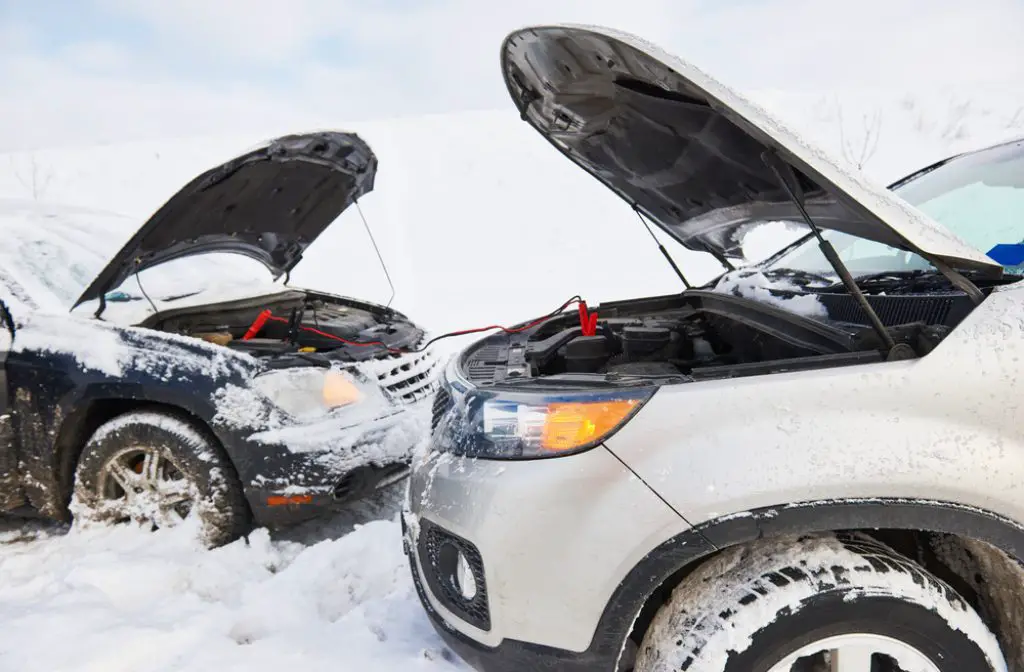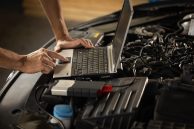We hope you love the products we recommend and just so you know that as an Amazon Associate EngineHoist.net may earn from qualifying purchases.
Winter can bring about a host of challenges, from sore throats to frozen pipes and even dead car batteries.
If you find yourself turning the key to no avail, don’t worry—I’m here to provide you with a quick rundown on how to jumpstart your car safely and effectively.
By following these 4 steps, you can learn how to jumpstart your car and avoid damaging your car’s electrical system and get back on the road in no time.
Table of Contents
Step 1 – Preparation and Setup
To get started, let’s make sure we have everything in place:
- Park the assisting car
- Position the assisting car nose-to-nose with your car, keeping a distance of about 18 inches between them.
- Ensure that both vehicles are in park and that their emergency brakes are engaged.
- Turn off the engines of both cars.
Step 2 – Connecting the Jumper Cables
Now let’s connect the jumper cables properly:
- Clamp the red end of the jumper cable to the positive terminal of your car’s dead battery.
- Attach the other end of the red cable to the positive terminal of the functioning car’s battery.
- Connect the black cable to the negative terminal of the working battery.
- Attach the other end of the black cable to a metal section, such as a bracket or bolt, at least a foot away from the dead battery. This helps ground the connection.

Step 3 – How to Jumpstart Your Car
With the cables properly connected, let’s move on to jumpstarting the car:
Starting the Working Car
- Start the working car’s engine and let it run for one to two minutes. This allows the functioning car’s battery to transfer some charge to the dead battery.
- During this time, gently rev the engine of the working car slightly to increase the charging effect.
Attempting to Start the Dead Car
- Now it’s time to give your car a try. Attempt to start the dead car.
- If it doesn’t start, don’t panic. Simply repeat the process, but avoid attempting to start the car more than three or four times in a row. This precaution helps prevent any damage to your car’s electrical system.
Step 4 – Disconnecting the Cables
Once the dead car is running, it’s important to disconnect the cables correctly:
- Start by disconnecting the cables in the reverse order in which you connected them.
- Begin by removing the black cable from the metal section that served as the ground connection.
- Next, detach the black cable from the negative terminal of the working battery.
- Then, remove the red cable from the positive terminal of the functioning car’s battery.
- Finally, disconnect the red cable from the positive terminal of your car’s dead battery.
Remember, always ensure that the clamps of the cables do not touch each other while disconnecting.
Step 5 – Charging the Battery
Now that your car is running again, let’s make sure the battery charges properly:
Driving the Car
- Drive your car for a while to allow the battery to charge to its full capacity. This helps ensure it will start reliably the next time you need it.
- If a short drive is insufficient, consider leaving the car parked and idling for a while with the lights off. This extended period can give the battery a chance to charge fully.
Troubleshooting
In some cases, jump-starting may not solve the problem entirely. Here are a few troubleshooting tips if your car refuses to start:
- Battery corrosion or fuse problems: Check for any corrosion on the battery terminals or blown fuses. Clean the terminals if necessary or replace any faulty fuses.
- Issues with the alternator, ignition switch, or starter connection: If the problem persists, it could indicate a deeper issue with these components. It’s advisable to seek professional assistance to diagnose and fix the problem.
- A completely dead battery: If the battery is unable to hold a charge even after multiple jump-start attempts, it may need to be replaced. Consult a professional to assess the condition of your battery and recommend the appropriate solution.
FAQs
How do you jumpstart your own car?
To jumpstart your own car, you can follow these steps: Connect jumper cables to the dead battery’s positive and negative terminals, then connect the other ends to the positive and negative terminals of a working car’s battery. Start the working car and let it run for a few minutes, then try starting your car.
How do you manually jumpstart a car?
To manually jumpstart a car, you need a set of jumper cables. Connect the positive (red) cable to the positive terminal of the dead battery and the other end to the positive terminal of the working car’s battery. Connect the negative (black) cable to the negative terminal of the working car’s battery, then attach the other end to a metal, grounded part of the dead car. Start the working car and let it run for a few minutes before attempting to start the dead car.
How do you jumpstart a car that won’t start?
If your car won’t start, you can jumpstart it by using jumper cables. Connect the positive (red) cable to the positive terminal of the dead battery and the other end to the positive terminal of a working car’s battery. Connect the negative (black) cable to the negative terminal of the working car’s battery and attach the other end to a metal, grounded part of the dead car. Start the working car and let it run for a few minutes, then try starting the dead car.
How do you start a car with a dead battery without another car?
If your car has a dead battery and don’t have another car available, you can use a portable jump starter or a battery booster pack. These devices provide the necessary power to jumpstart a car independently. Simply connect the jump starter or battery booster to your car’s battery according to the manufacturer’s instructions, and then attempt to start your car.
Conclusion
By following these step-by-step instructions, you can confidently jumpstart your car in winter without causing any harm to your vehicle.
Remember to park the assisting car correctly, connect the jumper cables properly, and follow the procedure for jumpstarting the car.
Always exercise caution when handling the cables and ensure you disconnect them in the correct order. If troubleshooting becomes necessary, consult a professional for further assistance.
Stay safe, and get back on the road with a reliable car in no time.








